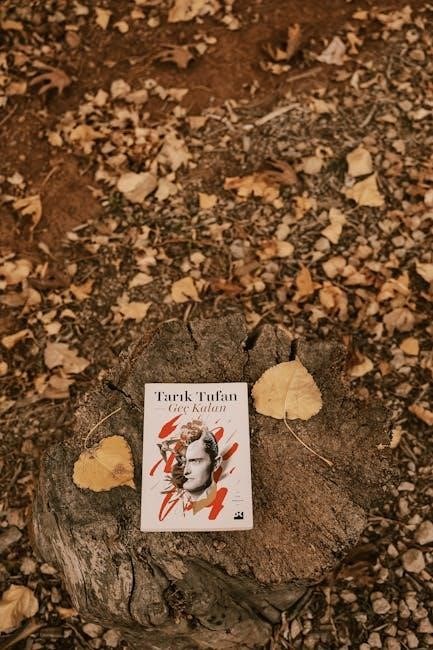Jon Krakauer’s “Into the Wild” tells the true story of Christopher McCandless, who abandoned society to live in the Alaskan wilderness, seeking self-discovery and freedom.
1.1 Overview of the Book and Its Author
“Into the Wild” is a nonfiction book by Jon Krakauer, published in 1996. It recounts the true story of Christopher McCandless, a young man who abandoned his comfortable life to explore the wilderness. Krakauer, a journalist and adventurer, became fascinated by McCandless’s journey after writing about it for Outside magazine. The book delves into themes of self-discovery, rebellion, and the human connection with nature. Krakauer’s vivid storytelling and meticulous research make the book a compelling exploration of adventure and personal philosophy, resonating deeply with readers worldwide;
1.2 The Tragic Story of Christopher McCandless
Christopher McCandless’s journey ended in tragedy when he died in the Alaskan wilderness in 1992. After graduating from college, he abandoned his possessions, donated his savings, and adopted the alias “Alexander Supertramp.” His quest for simplicity and freedom led him to live off the land, but the harsh environment and lack of preparation ultimately caused his demise. McCandless’s story, documented by Jon Krakauer, sparks debates about adventure, self-reliance, and the dangers of idealism, leaving a lasting impact on readers and inspiring reflection on life’s choices and societal expectations.
1.3 Why the Book is Popular Among Readers
“Into the Wild” resonates deeply with readers due to its exploration of universal themes like self-discovery, rebellion, and the human connection with nature. McCandless’s journey strikes a chord, inspiring admiration for his courage while sparking debates about his decisions. Krakauer’s compelling narrative and thorough research make the story relatable and thought-provoking, appealing to adventurers and introspective readers alike. The book’s ability to challenge societal norms and explore existential questions ensures its enduring popularity, making it a modern classic in nonfiction literature.

Author Background: Jon Krakauer
Jon Krakauer, born in 1954, is an American journalist and author known for his captivating narratives on adventure and the human condition. His work often explores themes of risk, nature, and personal challenge, making his writing both informative and emotionally engaging. Krakauer’s unique storytelling style has earned him a loyal readership and critical acclaim, solidifying his reputation as one of the most influential nonfiction writers of his generation.
2.1 Biography of Jon Krakauer
Jon Krakauer, born on April 12, 1954, in Oregon, grew up with a passion for storytelling and the outdoors. He studied environmental studies at Hampshire College, developing a deep connection with nature. After college, Krakauer worked as a journalist, honing his writing skills before gaining fame with “Into the Wild.” His unique narrative style, blending personal reflection with meticulous research, has captivated readers worldwide. Krakauer’s work often explores themes of adventure, risk, and human resilience, earning him widespread acclaim as a masterful nonfiction writer. His books continue to inspire and challenge readers to this day.
2.2 Krakauer’s Writing Style and Other Works
Jon Krakauer’s writing is known for its gripping narrative style, blending storytelling with deep research. His works often explore themes of human nature and the relationship between individuals and their environments. Beyond “Into the Wild,” Krakauer has authored notable books like “Into Thin Air” and “Under the Banner of Heaven,” which delve into themes of adventure, religion, and tragedy. His ability to connect personal stories with broader societal issues has made his writing resonate emotionally with readers, solidifying his reputation as a masterful nonfiction author. Krakauer’s unique voice continues to captivate audiences through his thought-provoking narratives.

Christopher McCandless: The Protagonist
Christopher McCandless, a young graduate, left a life of comfort to embrace wilderness adventures, adopting the name “Alexander Supertramp.” His tragic journey ended in Alaska, sparking profound reflection.
3.1 Early Life and Upbringing
Christopher McCandless grew up in a suburban Virginia family, raised by parents who valued achievement and material success. His father, a successful aerospace engineer, and his mother, a businesswoman, provided a comfortable lifestyle. Despite this, McCandless often felt stifled by societal expectations and the tension within his family. He developed a strong sense of self-reliance and idealism, which later influenced his decision to leave home. His upbringing shaped his desire for freedom and a simpler life, away from the pressures of modern society.
3.2 Motivations for Leaving Society
Christopher McCandless was driven by a deep desire for self-discovery and a rejection of materialism. He sought a simpler, more authentic life, free from societal expectations. His disillusionment with modern life and family conflicts further fueled his decision to leave. McCandless yearned to connect with nature and embrace freedom, which he found in the Alaskan wilderness. The “Magic Bus” became a symbol of his escape from the constraints of civilization, representing his quest for independence and a life untethered by societal norms.

Key Themes in “Into the Wild”
The book explores themes of self-discovery, rebellion, and the human relationship with nature. It highlights the tension between societal expectations and personal freedom, sparking deep reflection.
4.1 Self-Discovery and Adventure
At the heart of Into the Wild lies Christopher McCandless’s quest for self-discovery and adventure. Driven by a desire to escape societal norms, he embarked on a journey to reconnect with nature and himself. After graduating, McCandless donated his savings, abandoned possessions, and adopted a new identity, seeking a life of simplicity. His adventure reflects a universal human longing for freedom and authenticity. Through his travels, McCandless aimed to find meaning beyond materialism, embracing the wilderness as a path to inner truth and personal growth, even in the face of immense challenges and ultimate tragedy.
4.2 Rebellion Against Society
Christopher McCandless’s journey was deeply rooted in rebellion against societal expectations. Rejecting materialism and familial obligations, he sought a life untethered by conventional norms. McCandless’s decision to abandon his car, money, and possessions symbolized his defiance of modern society’s values. His actions were a critique of consumerism and the pressures to conform, reflecting a desire for autonomy and authenticity. Krakauer’s portrayal highlights McCandless’s belief that true freedom lies outside the constraints of societal structures, making his story a powerful exploration of individualism and rebellion.
4.3 Relationship with Nature
Christopher McCandless’s relationship with nature was central to his journey. He viewed the wilderness as a sanctuary, seeking solace and authenticity in its raw beauty. Nature represented freedom and escape from societal pressures, offering him a path to self-discovery and inner peace. However, the harsh realities of the Alaskan wilderness also tested his ideals, revealing both its beauty and brutality. McCandless’s connection with nature was deeply personal, reflecting his desire to live simply and authentically, yet ultimately highlighting the unforgiving power of the natural world.
4.4 Isolation and Loneliness
Christopher McCandless’s journey into the wild was marked by profound isolation and loneliness. His decision to leave society behind led to a life of solitude, where he often felt disconnected from humanity. While he sought freedom and self-discovery, the absence of human connection weighed heavily on him. McCandless’s experiences in the wilderness revealed both the beauty of solitude and the pain of loneliness, highlighting the duality of his quest for independence and his inherent need for human interaction.
The Journey of Christopher McCandless
Christopher McCandless’s journey began after college, as he donated his savings, abandoned possessions, and embarked on a path of self-discovery, leading to his tragic end in Alaska.
5.1 From College to the Wilderness
After graduating from Emory University, Christopher McCandless abandoned his material possessions and donated $24,000 to charity. He sought a simpler life, rejecting societal expectations and embracing nature. His journey led him to the Alaskan wilderness, where he aimed to live off the land. This decision marked the beginning of his odyssey, driven by a desire for freedom and self-discovery, ultimately shaping the tragic narrative of his life.
5;2 Encounters and Relationships Along the Way
Christopher McCandless formed meaningful connections during his journey, meeting individuals like Wayne Westerberg, Jan Burres, and Tracy Tatro, who influenced his path. These relationships highlighted his desire for human connection despite his quest for solitude. McCandless’s interactions often reflected his ideals of simplicity and honesty, contrasting with his strained family ties. These encounters shaped his experiences and provided moments of introspection, adding depth to his transformative journey into the wild.

The Discovery of McCandless’s Story
Jon Krakauer became fascinated with McCandless’s journey after reading about it in Outside magazine, leading him to deeply research and share the tragic yet inspiring tale.
6.1 How Jon Krakauer Became Interested in the Story
Jon Krakauer first learned about Christopher McCandless through an article in Outside magazine, which sparked his curiosity about the young man’s mysterious disappearance. Intrigued by McCandless’s rejection of societal norms and his fatal journey to Alaska, Krakauer began extensive research, interviewing those who knew McCandless and piecing together his final days. This fascination led Krakauer to write a deeply personal and investigative account, capturing the essence of McCandless’s quest for freedom and self-discovery.
6.2 The Impact of the Book’s Publication
Since its release in 1996, “Into the Wild” has sparked widespread debate and admiration, becoming a bestseller. The book inspired many to reevaluate their lives and seek adventure, while others criticized McCandless’s decisions as reckless. Its publication ignited discussions about self-discovery and societal expectations, resonating deeply with readers worldwide. The story’s controversial nature has made it a cultural phenomenon, leaving a lasting impact on literature and public discourse about wilderness exploration and personal freedom.

Critical Reception and Reviews
“Into the Wild” received widespread acclaim for its compelling narrative, but also faced criticism for its portrayal of McCandless and his controversial choices, sparking debates among readers.
7;1 Positive Feedback from Readers
Readers praised “Into the Wild” for its gripping storytelling and emotional depth. Many found McCandless’s journey inspiring, resonating with themes of self-discovery and rebellion. The book’s ability to provoke reflection on freedom, societal expectations, and personal identity struck a chord. Krakauer’s vivid descriptions and insightful analysis were particularly commended, making the narrative both haunting and thought-provoking. Fans appreciated how the story balanced adventure with philosophical inquiry, leaving a lasting impression on its audience. Its relatability and universal themes have cemented its place as a modern literary classic.
7.2 Controversies and Criticisms
Despite its popularity, “Into the Wild” faced criticism for its portrayal of McCandless. Some viewed him as reckless rather than idealistic, questioning his decision to abandon family and possessions. Critics argued Krakauer romanticized McCandless’s choices, potentially inspiring dangerous imitations. Others felt the book lacked objectivity, focusing too much on McCandless’s perspective. Additionally, ethical concerns were raised about the legal and moral implications of distributing the book in PDF format without authorization, highlighting issues of copyright infringement and the impact on authors and publishers.

The Book’s Structure and Narrative
The book employs a non-linear narrative, blending multiple perspectives and flashbacks to create a compelling exploration of McCandless’s journey and its profound implications.
8.1 Nonlinear Storytelling Technique
Jon Krakauer’s “Into the Wild” employs a nonlinear narrative structure, beginning with Christopher McCandless’s death and then retracing his journey through flashbacks. This technique builds suspense and engages readers by gradually revealing the events that led to his tragic end. The nonlinear approach mirrors the investigative nature of the story, as Krakauer pieces together McCandless’s life from interviews, journals, and evidence. This structure not only enhances the emotional depth but also underscores the themes of adventure, rebellion, and self-discovery, making the narrative both compelling and thought-provoking.
8.2 Use of Flashbacks and Multiple Perspectives
Krakauer uses flashbacks to delve into McCandless’s past, revealing his motivations and emotional struggles. Multiple perspectives enrich the narrative, offering insights from people who knew McCandless, such as his family and those he met on his journey. These diverse viewpoints create a layered understanding of his character and actions, balancing sympathy with criticism. The interplay of past and present, along with varied voices, adds complexity to the story, making it a nuanced exploration of McCandless’s life and the choices that led to his ultimate fate in the wilderness.

Symbols and Literary Devices
Krakauer employs symbols like the Alaskan wilderness and the abandoned bus, representing freedom and escape, while literary devices such as foreshadowing and imagery deepen the narrative’s emotional impact.
9.1 The Role of the Bus in the Story
The old bus McCandless discovers in Alaska symbolizes freedom and escape, becoming his temporary home. It represents his rejection of materialism and quest for simplicity. The bus also serves as a refuge, offering shelter from the harsh wilderness. However, it ultimately becomes a tragic symbol of his isolation and fate. Years later, the bus gains a cult following, with adventurers visiting it as a shrine to McCandless’s ideals, highlighting the enduring impact of his story on readers and explorers worldwide.
9.2 Symbolism of the Alaskan Wilderness
The Alaskan wilderness in “Into the Wild” represents a realm of pure freedom and self-discovery. It symbolizes McCandless’s quest for authenticity, away from societal constraints. The vast, untouched land embodies both beauty and danger, mirroring his internal journey. The wilderness is not just a physical landscape but a metaphor for the unknown, challenging McCandless to confront his limits. It serves as a catalyst for his transformation, offering solace yet testing his resilience, ultimately reflecting the human desire to connect with nature and find inner truth;

Availability of “Into the Wild” in PDF Format
“Into the Wild” is widely available in PDF format, but downloading it may raise legal and ethical concerns. Always opt for official sources or purchase the book.
10.1 Legal and Ethical Considerations
Accessing “Into the Wild” in PDF format requires adherence to copyright laws. Downloading pirated copies is illegal and unethical, as it deprives authors and publishers of rightful income. Always obtain the book through legitimate sources like purchases or library loans to support the creators and respect intellectual property rights.
10.2 Where to Find the Book Legally
Readers can legally access “Into the Wild” through various platforms. Purchase the e-book or paperback from online retailers like Amazon or Barnes & Noble. Libraries offer free rentals, while services like Audible provide audiobook versions. Ensure to support authors and publishers by using legitimate sources for the best reading experience.

Cultural Impact of the Book
“Into the Wild” has inspired countless adventurers and sparked debates about societal expectations, self-discovery, and the human relationship with nature, leaving a lasting cultural imprint globally.
11.1 Inspiring Adventurers and Wanderers
“Into the Wild” has become a beacon for adventurers and wanderers, motivating many to embrace simplicity and pursue their own journeys of self-discovery. The book’s themes of rebellion and the search for meaning resonate deeply, encouraging readers to question societal norms and seek fulfillment in the wild. McCandless’s story serves as a powerful reminder of the enduring human quest for freedom and authenticity, inspiring countless individuals to step beyond their comfort zones and explore the unknown.
11.2 Critics of McCandless’s Choices
While some admire McCandless’s bold rejection of materialism, others criticize his decisions as reckless and naive. Critics argue that his lack of preparation and understanding of the wilderness led to his tragic demise. They question his romanticization of nature and suggest that his actions were more impulsive than heroic. This criticism highlights the debate over whether McCandless’s journey was a noble quest for freedom or a dangerous disregard for reality, sparking discussions on responsibility and the true cost of adventure.
“Into the Wild” leaves readers reflecting on McCandless’s journey, sparking debates about freedom, recklessness, and self-discovery. His story remains a powerful testament to adventure and its costs.
12.1 Final Thoughts on the Book’s Significance
“Into the Wild” remains a profound exploration of human nature, challenging readers to reflect on societal norms, personal freedom, and the quest for meaning. McCandless’s story, while tragic, inspires contemplation about adventure, self-discovery, and the boundaries between courage and recklessness. Krakauer’s narrative masterfully balances empathy and critique, leaving a lasting impact on readers. The book’s enduring popularity underscores its ability to provoke thought and resonate with those seeking deeper connections with nature and themselves, ensuring its relevance for generations to come.
